|
Chapter I: Prehistoric
and Animist Periods
A.
Prehistoric Sites
1. Introduction
As infrequent archaeological excavations have slowly
revealed pieces of
Burma's past, a better but still
incomplete understanding of Burma's prehistory
has slowly emerged. Scant archaeological evidence suggests that cultures
existed in Burma as early as 11,000 BC, long before the more recent
Burmese migrations that occurred after the 8th century AD. The
conventional western divisions of prehistory into the Old Stone Age, New
Stone Age and the Iron or Metal Age are difficult to apply in Burma
because there is considerable overlap between these periods. In Burma,
most indications of early settlement have been found in the central dry
zone, where scattered sites appear in close proximity to the Irrawaddy
River. Surprisingly, the artifacts from these early cultures resemble
those from neighboring areas in
Southeast Asia as well
as India. Although these sites are situated in fertile areas,
archaeological evidence indicates that these early people were not yet
familiar with agricultural methods.
The Anyathian,
Burma's
Stone Age, existed at a time thought to parallel the lower and middle
Paleolithic in Europe.
At least six kinds of stone hand tools have been discovered in the
fourteen sites associated with this period. This assemblage of stone
tools in conjunction with additional archaeological evidence indicates
that these people lived by hunting animals and gathering wild fruits,
vegetables and root crops.
The Neolithic or New Stone Age, when plants and animals
were first domesticated and polished stone tools appeared, is evidenced in
Burma by three caves located near Taunggyi at the edge of the Shan plateau
that are dated to 10000 to 6000 BC. The most complex of these, the
Padhalin cave, contains wall paintings of animals, not unlike those found
in the Neolithic caves at Altimira, Spain or Lascaux, France. These
paintings may be interpreted as an indication that the cave was used as a
site for religious ritual. Thus, caves were among the earliest sites used
for Buddhist worship in Burma. This is of importance because the use of
caves for religious purposes continued into later periods and may be seen
as a "bridge" between
the earlier non-Burmese, Animist period and the later Buddhist period.
Numerous caves around the ancient city of Pagan have been outfitted with
Buddha images or have been incorporated into early temples such as Kyauk
Ku Umin or Thamiwhet and Hmyatha Umin.
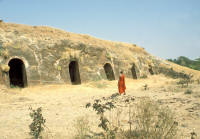
Thamiwhet Umin, Nyaung-o, Pagan |
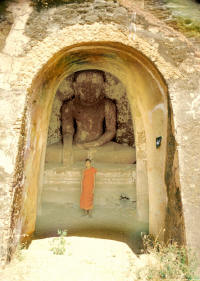
Buddha image erected inside Thamiwet Umin |
A Buddhist temple is referred to as a cave, whether it is
naturally formed or, as is most often the case, architecturally
constructed. The Burmese word for cave is "gu"
and has been continually used to refer to Buddhist temples. It is
frequently incorporated into the name of a temple, for example Shwe Gu Kyi
or Penatha Gu. Also, until the twelfth century, temple interiors were
intentionally dimly lit. This effect was achieved by installing permanent stone
or brick lattices in all the relatively small windows. (The Burmese ethnic
group has been credited with building their temples with larger,
unobstructed windows and thereby creating more brightly-lit interiors
- a transition that is seen in the temples of the Pagan Period).
By the second half of
the first millennium BC a new developmental phase began in the dry zone of
Burma. Referred to as the early Bronze - Iron Age, these cultures shared
practices and methods of production with various neighboring areas.
Burial methods resemble those of Thailand and Cambodia. Iron working
technology most likely came from India or other parts of Southeast Asia,
and ceramic forms and decoration correspond to those of the bronze - iron
Age levels at Ban Chiang in northern Thailand and at Samrong Sen in
Cambodia. Numerous beads have been recovered that stylistically resemble
those imported from Andrha Pradesh and Tamil Nadu in India.
2. Prehistoric: Early man at Taungthaman
The site of Taungthaman is located near the 19th century
city of Mandalay, on an alluvial terrace of the Irrawaddy River within the
walls of the 18th century capital, Amarapura, and was occupied from the
late Neolithic through the early iron age, around the middle of the first
millennium BC. Many artifacts have been uncovered at Taungthaman such as
sophisticated stone tools, intricate ceramic wares, and primitive iron
metallurgy. Many of these objects would have been acquired from the
prosperity gained through industrious farming and trade. When burying
their dead, their new affluence encouraged these people to include among
the grave goods fine decorative ceramics produced by specialized potter
artisans as well as the more common household objects such as bowls and
spoons. Human and animal figures discovered at Taungthaman in the 1970's
are thought to have been used for religious practices. If this is so,
these artifacts represent the oldest of their kind found in Burma.
Although no building in permanent material was discovered at Taungthaman,
the excavations uncovered a pattern of post-holes that are the results of
buildings having been supported on wooden pilings.
|
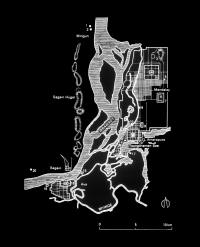
The mighty bend in the Irrawaddy inhabited since
prehistoric times |
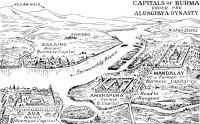
Capitols of Burma |
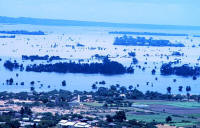
Taugthaman area in annual flood |
|
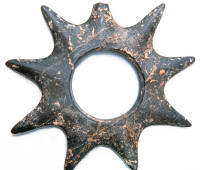
Stone bracelet from Taungthaman |
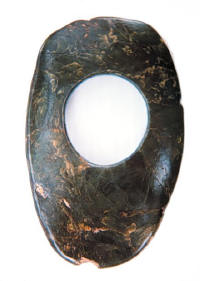
Stone
hoe? from Taungthaman |
|
3. Transition to Pre-Pagan
Period
From the limited information available at present, the
evolution of these early prehistoric cultures into the later Mon and Pyu
societies is not well understood, although the late Iron Age coincided
with the rise of Pyu culture and the creation of the first cities in
Burma. However, there is ample evidence that by the fifth century AD, the
Mon as well as the Pyu peoples had adopted the Indianized cultural life
then widely practiced throughout mainland Southeast Asia which included
elements of both Hinduism (Brahamanism) as well as aspects of Theravada,
Mahayana, and Tantric Buddhism.
Bibliography- Prehistoric
Period
Aung Thaw,
'The
"Neolithic Culture of the
Padah-lin Caves",
Asian Perspectives, 14 (1971), pp. 123-133.
Ba Maw, "Research on Early
Man in Myanmar", Myanmar Historical Research
Journal, no.1 (November 1995), pp. 213-220.
Bob Hudson, "The Nyaungyan
'Goddesses': Some
Unusual Bronze Grave Goods from Upper Burma",
TAASA Review, vol 10, no 2 (June 2002), pp. 4 Ė7.
William Solheim, "New Light on a
Forgotten Past", National Geographic, vol
139, No. 3 (March 1971), pp. 330-339.
B.
Animism and the Arts
1. Animism
Animism is a generic
term used to describe the myriad religious beliefs and practices that have
been utilized in small-scale human societies since the beginning of the
prehistoric era and is the earliest identifiable form of religion found in
Burma. This is not an unexpected occurrence because animist beliefs and
practices have been found among early human societies in almost every
country of the world. Animism is a belief that spirits exist and may live
in all things, sentient and non-sentient. The world is thought to be
animated by all sorts of spirits that may intervene negatively or
positively in the affairs of men. Although spirits may live in all
things, every object does not harbor a spirit. If there were a spirit in
everything, the daily activities of mankind would be seriously disrupted
because a spirit would have to be addressed or placated at every step in a
day's activities. Spirits by their very nature
are thought to be normally invisible and to assume visible form only on
rare occasion. Therefore, it is a challenge for anyone to contact a
specific spirit and be absolutely sure that the correct spirit was
contacted and was present. Therefore, throughout the world, spirits are
often assigned a contact point where they may be enticed for
consultation. Salient features of the landscape often become the
"home" of a spirit by
assignment. Spirits are thought to live, for example, on the highest peak
in a mountain range or at the odd bend in the creek but not in every stone
or drop of water. If a landscape is devoid of a salient feature, such as
is the case with a flat rice field, one is created by assignment such as
building a simple shrine in the northeast corner of the field. That the
spirits have a recognized "home"
is important since the relevant spirit or spirits must be located and
consulted before important decisions are made or an activity undertaken.
Location as well as "presence"
is of vital importance in animism because the spirit must be agreeably
enticed to the location so that the request will meet with a
positive response. A home or locus for consulting ancestor spirits is
often created in animist societies by carving a generic but gendered human
image and wrapping it in a garment or with possessions identified with the
deceased. Gifts of all kinds, often of luxury goods, are ritually
presented to the image when it may be wrapped in any of the deceased
individual's possessions.
In virtually all
societies that practice animism, there are three broad categories of
spirits: Spirits of the Ancestors, Spirits of the Locale or Environment
(often referred to as genie of the soil) and Spirits of Nature or Natural
Phenomenon. Those individuals who were important in this life, such as
patriarchs, matriarchs, clan leaders, political leaders, or chiefs, are
honored after their death because it is believed that if they were
powerful in this life then they will be powerful in the afterlife and
consequently they should be consulted. Security for the living is achieved
and maintained by consulting these important ancestor spirits to receive
advice on major decisions and assistance to bring them to fruition.
Spirits of the locale
or environment include, for example, the spirit of the mountain, the
waterfall, the great tree or of each plot of land. In inhabited areas in
Burma and especially within villages or towns, almost every large tree has
a spirit shelf on which food and drink is placed to please the spirit and
thus assure its blessings. The small wayside shrines, typically containing
no images that are found along thoroughfares as well as in remote
locations throughout Burma are dedicated to the spirit(s) of that area,
that tract of land or that city plot.
The Spirits of Natural
Phenomenon are consulted as needed. These include the sun, moon, storms,
hurricanes, typhoons, winds and earthquakes. These spirits represent the
uncertainty of the world; that which is beyond the understanding and
complete control of the living.
Animism is typically
practiced through rituals that are performed by a specially trained
practitioner who serves as an intermediary between a person or group and
the spirit to be consulted. The term shaman -
the word used for such an individual in tribes living along the American
Northwest
Coast - is today widely employed by academics to identify such individuals
wherever they appear in the world. This practitioner is called to perform
a ritual at an auspicious location in which he entices the appropriate
spirit or spirits to appear and cooperate by flatteringly calling them by
name, performing their favorite music or songs, recounting their good
deeds and offering them the things that they enjoyed when alive, such as
food, drink (frequently alcohol), or things that have an appealing
fragrance such as flowers or incense. These "objects
of enticement" are considered by outsiders to be
the Arts of Animism. Since animist rituals often do not require an image,
these arts frequently consist of the objects used for enticement such as
fine textiles, fine basketry or fine ceramics. Typically these items are
the best available, expensive, newly made for the ceremony, or at least
refurbished since it would be offensive to offer old clothing or stale
food to a respected individual. Once the shaman is convinced the desired
spirit is present and in an agreeable mood, he goes into trance and
consults with the spirit concerning the critical matter at hand. He then
comes out of trance and shares the wishes of the spirit(s) with his
client(s).
There are typically
three categories of questions that are asked: those that involve the
security of the group or person; the fertility of humans, livestock and
crops; and the health of the group or the individual. All three
categories of questions have to do with everyday life, the here and now,
and unlike the "Great Religions",
little attention is focused on the afterlife.
The practitioners of
animism, the shaman or mediums, do not belong to an organized clergy but,
instead, learn the rituals and the practices of animism by having been an
apprentice or an acolyte to another shaman. The specialized task of the
shaman requires them to communicate with spirits, whether male or female,
while in a trance. Consequently, an individual of ambiguous gender is well
suited to speak intimately with spirits of either gender. Therefore,
shaman tends to be either effeminate males or masculine females who at
their will are capable of going into trance.
In Burma, animism has
developed into the cult of the Thirty-Seven Nats or spirits. Its spirit
practitioners, known as nat ka daws, are almost always of ambiguous
gender, and are thought to be married to a particular spirit or nat.
Despite their physical appearance and costume, however, they may be
heterosexual with a wife and family, heterosexual transvestites, or
homosexual. Being a shaman is most often a well-respected profession
because the shaman performs the functions of both a doctor and a minister,
is often paid in gold or cash, and is often unmarried with the time and
money to care for their aging parents. Shamans who combine their
profession with prostitution lose the respect of their clients
- a universal conflict and outcome. The
reputation of Burmese nat-ka-daws has been generally damaged by this
conflict.
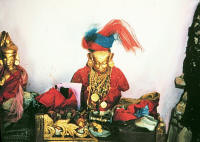
Nat images in Nat shrine, Shwezigon Stupa,
Pagan
|
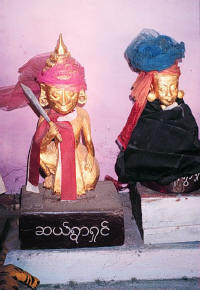
Nat images in Nat shrine, Shwezigon Stupa, Pagan
|
Animism, a generic
term for the Small Religions, is a substratum of beliefs out of which the
Great Religions have developed. It is a useful term to describe all of the
small religions that vary greatly in the specifics of their practice.
However, there are general characteristics that are easily recognized.
Since animism is based upon the worship of individuals who once lived in
addition to spirits that dwell in specific environmental locations, there
are a myriad number of spirits. These spirits change in name and function
in different physical environments. Consequently, the names of the spirits
change from valley to valley, from one village to another or from one
small group to the next. The worship of numerous spirits differs markedly
from the great religions, which usually have one all encompassing god or a
limited pantheon of gods. By comparison, in Burma and Thailand there is a
spirit attached to every parcel of land.
Since Animism is
typically practiced by non-literate groups of people, a written record of
their theology or literature doesn't exist.
Practices or beliefs are passed down orally from shaman to apprentice.
Since it is important for the shaman to preserve the correct order in
which chants and genealogies must be recited, shaman in several societies
have independently invented what scholars have come to refer to as
"memory boards". These
are boards on which there are a series of symbols or marks that assist in
proper recollection and recitation. These boards have been found in many
small-scale societies including those in Southeast Asia, particularly in
Borneo
and as far away as
Easter Island. These boards, although often undecipherable
to the uninitiated, are important because they are examples of the first
form of writing.
Art objects used in
animism are typically made of perishable materials. The images are often
of wood, cane, feathers, leather, and other materials such as unfired clay
that easily disintegrate. Due to humidity, bacteria, and the foraging of
animals and insects, these art forms do not last for long periods. Art
forms made of perishable materials are suitable for animist ritual since
the animist aesthetic places importance on the new and beautiful because
the end goal is to please and attract the spirits. The sentiment here is
that attractive gifts should be new and not secondhand. Therefore, old
images that have been used previously are frequently repainted, re-dressed
or made anew. At times, the "art objects"
are discarded after a ritual since the objects have served their purpose
of attracting the spirit and the spirit by its very nature of being a
spirit can not take the objects away.
Animist art obects are
created in almost any form. The images may be anthropomorphic, or just an
uncut slab of rock. The object may be adorned or unadorned.
In Burma, the major
Animist spirits were transformed into the Pantheon of the 37 Nats during
the Pagan Period. The earliest known images of the brother and sister nats,
Min Mahagiri and his Sister, who lead the pantheon, were painted on two
planks hewn from a their sacred tree that had been thrown into the
Irrawaddy and had floated down the Irrawaddy to Pagan.
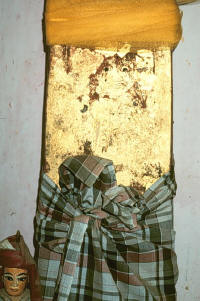
Min Mahagiri in nat shrine, Shwezigon, Pagan |
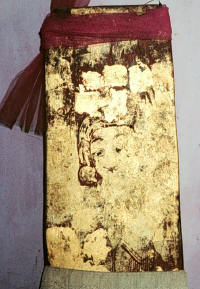
Mahagiriís Sister, Shwemyethna, Princess Golden Face
in
nat shrine, Shwezigon Stupa, Pagan |
2. Bronze Drums - An
Animist Art Form
The use and manufacture of bronze drums is the oldest
continuous art tradition in Southeast Asia. It began some time before the
6th century BC in northern Vietnam and later spread to other areas such as
Burma, Thailand, Indonesia and China. The Karen adopted the use of bronze
drums at some time prior to their 8th century migration from
Yunnan into Burma where they settled and continue to live in the low
mountains along the Burma - Thailand border.
During a long period of adoption and transfer, the drum type was
progressively altered from that found in northern Vietnam (Dong Son or
Heger Type I) to produce a separate Karen type (Heger Type III). In 1904,
Franz Heger developed a categorization for the four types of bronze drums
found in Southeast Asia that is still in use today.
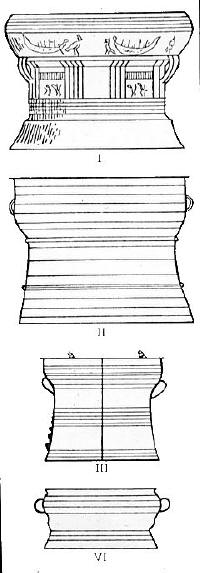
Hegerís four drum types |
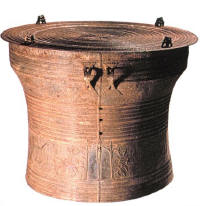
The Karen Drum Type or Heger Type III |
The vibrating tympanum is made of bronze and is cast as a
continuous piece with the cylinder. Distinguishing features of the Karen type
include a less bulbous cylinder so that the cylinder profile is continuous
rather than being divided into three distinct parts. Type III has a
markedly protruding lip, unlike the earlier Dong Son drums. The decoration
of the tympanum continues the tradition of the Dong Son drums in having a
star shaped motif at its center with concentric circles of small,
two-dimensional motifs extending to the outer perimeter.
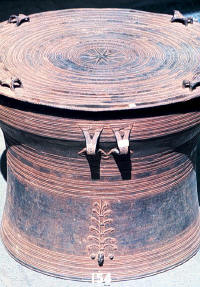
Tympanum of a Karen Bronze Drum |
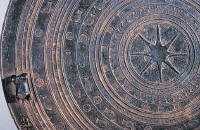
Complete Tympanum of a Karen Drum |

Detail of Tympanum of a Karen Drum |
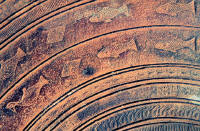
Detail of Tympanum of a Karen Drum |
In Burma the drums are known as frog drums (pha-si), after
the images of frogs that invariably appear at four equidistant points
around the circumference of the tympanum.
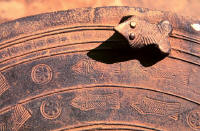
Frog on Tympanum of a Karen Drum
A Karen innovation was the addition of three-dimensional
figures to one side of the cylinder so that insects and animals, but never
humans, are often represented descending the trunk of a stylized tree.

Stylized tree with snails and elephants |
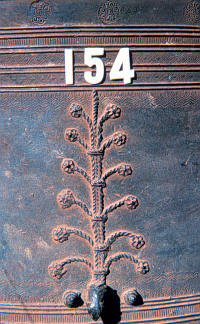
Detail of stylized tree with snails and elephants
|
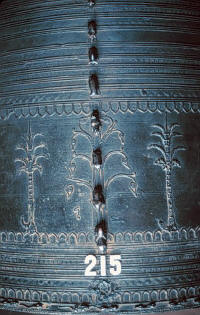 Detail showing a
complex arrangement of snails, elephants, trees squirrels and other
animals. |
The frogs on the tympanum vary from one to three and, when
appearing in multiples, are stacked atop each other. The number of frogs
in each stack on the tympanum usually corresponds to the number of figures
on the cylinder such as elephants or snails. The numerous changes of motif
in the two- and three-dimensional ornamentation of the drums have been
used to establish a relative chronology for the development of the Karen
drum type over approximately one thousand years.
The Karens speak
several languages that linguists have had difficulty classifying.
Karen groups often speak different languages, some of which are not
mutually intelligible. Hence, the Karen peoples are an exception to the
basic assumption that an ethnic group can be defined by the fact that all
its members can converse in a single tongue. There are at least three
major cultural and linguistic divisions among the Karen: the Karreni or
the Red Karen, who cast the bronze drums, the Pwo Karen, and the Sgaw
Karen, as well as a number of other splinter groups who have scattered
into the mountains below the Shan Plateau.

Two Red Karen Women |
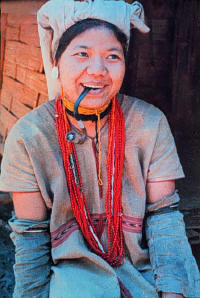
A Sgaw Woman |
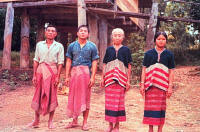
Two Sgaw Karen couples |
These hillside people practice swidden or slash-and-burn
agriculture and speak a language that is very different than that of the
lowland Burmese. The practice of slash-and-burn agriculture consists of
burning the forests and then using the ashes from the burnt timber as
fertilizer for the fields.
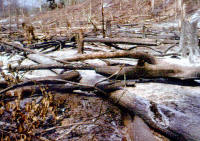
A swidden field ready for planting |
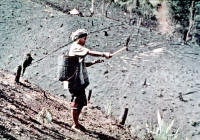
Broadcasting rice in swidden field |
The fertilizer lasts for only several years, never more
than six, and at that time the Karen must pack and move everything to a
new site where a different section of the forest is burned. A number of
hillside groups practice slash-and-burn agriculture and periodically move
through each other's hereditary territory to new lands. These people
move back and forth across the Thai border with little regard for the national boundary.
Slash-and-burn agriculture is perilous in that after the forest is burned, seeds must be planted and then rains must occur quickly and
consistently until the plants are well established. If this does not
happen, the plants will wither and die or insects and animals will eat the
seeds. It is not unusual for the Karen to be forced to plant four times
in order to reap a single harvest. For the Karen, the bronze drums
perform a vital service in inducing the spirits to bring the rains. When
there is a drought, the Karens take the drums into the fields where they
are played to make the frogs croak because the Karens believe that if the
frogs croak, it is sign that rain will surely fall. Therefore, the drums
are also known as "Karen Rain Drums"
Bronze drums were used
among the Karen as a device to assure prosperity by inducing the spirits
to bring rain, by taking the spirit of the dead into the after-fife and by
assembling groups including the ancestor spirits for funerals, marriages
and house-entering ceremonies. The drums were used to entice the spirits
of the ancestors to attend important occasions and during some rituals the
drums were the loci or seat of the spirit.
It appears that the
oldest use of the drums by the Karen was to accompany the protracted
funeral rituals performed for important individuals. The drums were played
during the various funeral events and then, among some groups, small bits
of the drum were cut away and placed in the hand of the deceased to
accompany the spirit into the afterlife. It appears that the drums were
never used as containers for secondary burial because there is no instance
where Type III drums have been unearthed or found with human remains
inside. The drums are considered so potent and powerful that they would
disrupt the daily activities of a household so when not in use, they were
placed in the forest or in caves, away from human habitation. They were
also kept in rice barns where when turned upside down they became
containers for seed rice; a practice that was thought to improve the
fertility of the rice. Also, since the drums are made of bronze, they
helped to deter predations by scavengers such as rats or mice.
When played, the drums
were strung up by a cord to a tree limb or a house beam so that the
tympanum hung at approximately a forty-five degree angle.
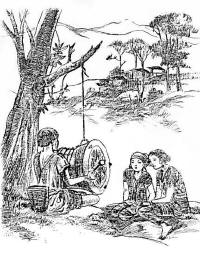
Karen drum being
played
The musician placed
his big toe in the lower set of lugs to stabilize the drum while striking
the tympanum with a padded mallet. Three different tones may be produced
if the tympanum is struck at the center, edge, and midpoint. The cylinder
was also struck but with long strips of stiff bamboo that produces a sound
like a snare drum. The drums were not tuned to a single scale but had
individualized sounds, hence they could be used effectively as a signal to
summon a specific group to assemble. It is said that a good drum when
struck could be heard for up to ten miles in the mountains. The drums were
played continuously for long periods of time since the Karen believe that
the tonal quality of a drum cannot be properly judged until it is played for
several hours.
The drums were a form
of currency that could be traded for slaves, goods or services and were
often used in marriage exchanges. They were also a symbol of status, and
no Karen could be considered wealthy without one. By the late nineteenth
century, some important families owned as many as thirty. The failure to
return a borrowed drum often led to internecine disputes among the Karen.
a. Animist Drums and Buddhism
Although the drums
were cast primarily for use by groups of non-Buddhist hill people, they
were used by the Buddhist kings of Burma and Thailand as musical
instruments to be played at court and as appropriate gifts to Buddhist
temples and monasteries. The first known record of the Karen drum in Burma
is found in an inscription of the Mon king Manuha at Thaton, dated 1056
AD. The word for drum in this inscription occurs in a list of musical
instruments played at court and is the compound pham klo: pham is Mon
while klo is Karen. The ritual use of Karen drums in lowland royal courts
and monasteries continued during the centuries that followed and is an
important instance of inversion of the direction in which cultural
influences usually flow from the lowlands to the hills.
b. Casting the drums
The town of Nwe Daung,
15 km south of Loikaw, capital of Kayah (formerly Karenni) State, is the
only recorded casting site in Burma. Shan craftsmen made drums there for
the Karens from approximately 1820 until the town burned in 1889.
Karen drums were cast by the lost wax technique; a characteritic that sets
them apart from the other bronze drum types that were made with moulds. A five metal formula was used
to create the alloy consisting of copper, tin, zinc, silver and gold. Most
of the material in the drums is tin and copper with only traces of silver
and gold. The Karen made several attempts in the first quarter of the
twentieth century to revive the casting of drums but none were successful.
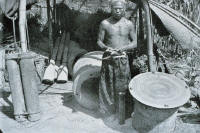
Karen drums casting
- 1923
During the late 19th
century, non-Karen hill people, attracted to the area by the prospect of
work with British teak loggers, bought large numbers of Karen drums and
transported them to Thailand and Laos. Consequently, their owners
frequently incorrectly identify their drums as being indigenous to these
countries.
Bibliography
- Animism and the Arts
F. Heger, Alte
Metalltromeln aus Sudest-Asie (Leipzig, 1902).
H. I. Marshall, The
Karen People of
Burma: A Study in Anthropology and
Ethnology (Columbus,
1922).
H. I. Marshall,
"Karen Bronze Drums",
Journal of the Burma Research Society, xix (1929), pp. 1-14.
Richard M. Cooler,
"The Use of Karen Bronze Drums in the Royal
Courts and Buddhist Temples of Burma and Thailand: A Continuing Mon
Tradition?", Papers from a Conference on Thai
Studies in Honor of William J. Gedney (Michigan Papers on South and
Southeast Asia, No 25, Ann Arbor, 1986) pp. 107-20.
Richard M. Cooler,
The Karen Bronze Drums of
Burma: Types, Iconography,
Manufacture, and Use (Leiden,
1994). |